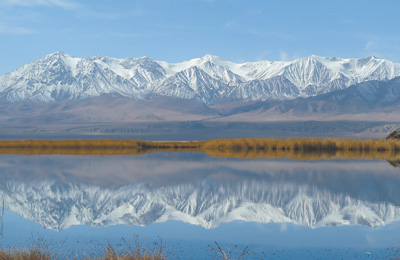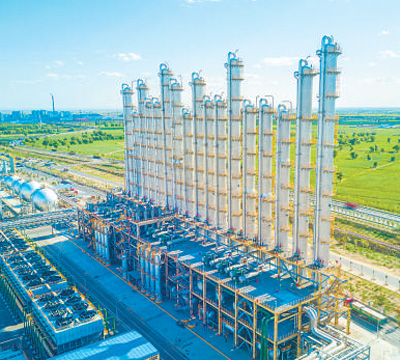Inner Mongolia, Gansu protect local ecological environment while maintaining prosperity and stability
Under the leadership of the Communist Party of China, people of all ethnic groups in north China’s Inner Mongolia Autonomous Region and northwest China’s Gansu Province have rallied closely together to forge ahead in their efforts to build the country’s northern border areas into a more beautiful place while maintaining prosperity and stability there.

Photo shows the beautiful scenery of the Yanchiwan wetland in Subei Mongolian Autonomous County, northwest China’s Gansu Province. (Photo/Se Yongjun)
Spanning across the vast northern territory of China, the Greater Hinggan Mountains and Yinshan Mountains in Inner Mongolia, as well as the Helan Mountain in Gansu together constitute a vital ecological bulwark in the country’s northwest.
Inner Mongolia has treated the goals of building itself into an ecological safety bulwark and promoting ecological protection as major priorities. It has carried out the holistic conservation and systematic governance of its mountains, rivers, forests, farmlands, lakes, grasslands and deserts, and has incorporated over 50 percent of its land area into its ecological “red lines” for environmental conservation. In recent years, the autonomous region’s steppe vegetation coverage rate and forest coverage rate have both continued to expand, while its desertification coverage and sandy desertification coverage have both decreased steadily.
Zhou Yizhe, who worked as a logger for more than 30 years, became a forest ranger after natural forest logging activities in the Greater Hinggan Mountains were fully banned in 2015.
“Now, as the ecology in the Greater Hinggan Mountains gets better, the numbers of wild animals such as bears, roe deer, and wild boars have continued growing. Besides, tourism and forest-dependent industries have been thriving,” Zhou said.
Since 2021, the transaction volume for the carbon sink trading of the Inner Mongolia Forest Industry Group, the company Zhou works for, has reached 26 million yuan (about $3.88 million).

Photo shows a new energy project in Kundulun district, Baotou city, north China’s Inner Mongolia Autonomous Region. (Photo/Feng Xue)
Gansu Province started to fix the environmental problems affecting the Qilian Mountain National Nature Reserve in 2017. By combining the natural restoration of the environment and comprehensive governance, Zhangye city in the province has launched large-scale land afforestation efforts. So far, over 18.9 million trees have been planted on 60,000 mu (4,000 hectares) of land in a forested area, which was once dotted with sand and gravel interspersed with plants; while 37 new ponds and reservoirs have also been built in the same forested area.
Meanwhile, traditional industries are being upgraded in the locality, while emerging sectors are continuing to boom. At the Haerwusu open-pit coal mine in Erdos city of Inner Mongolia, unmanned trucks are used to unload coal. At present, the mine has upgraded 36 unmanned trucks as well as the collaboration systems for multiple auxiliary devices, according to Guo Anbin, deputy head of the coal mine.
The autonomous region has raised the efficiency with which its energy and resource are used, and has accelerated the development of a clean, low-carbon, safe and efficient energy system. Last year, Inner Mongolia sent a total of 580 million tonnes of coal and 246.7 billion kilowatt-hours of electricity out of the region.
With rich wind energy resources, an expansive territory and a sparse population, Inner Mongolia and northern Gansu have unique advantages in terms of developing clean energy.
In Minqin county, Wuwei city of Gansu, a 400-megawatt wind farm was built by the CGN Gansu Minqin No. 2 Wind Power Generation Co., Ltd. The wind farm has sent 5 billion kilowatt-hours of electricity out of the county, which is equivalent to saving over 1 million tonnes of standard coal or an emission cut of more than 3 million tonnes of CO2, said Yang Xiao, an executive from the wind farm.
In Inner Mongolia, the installed capacity of new energy accounts for 35 percent of its total, while the electricity generation from new energy makes up 20 percent of its total, which is expected to surpass thermal power by 2030. Non-coal industries in the autonomous region account for about 60 percent of the added value of industrial enterprises above the designated size, which includes those enterprises with an annual primary business revenue of 20 million yuan or more.

Photo shows an open-pit coal mine in Tongliao city, north China’s Inner Mongolia Autonomous Region. (Photo/Zhang Shengjun)
The two provincial-level regions have also seen improvements in the high-quality development of foreign trade. In recent years, Inner Mongolia has changed the mode of transit and distribution channels for raw materials and has gradually formed a development pattern that integrates the import and processing of raw materials and sales of processed products. Since 2021, the total value of imports and exports between Gansu and countries along the Belt and Road has reached 30 billion yuan, while imports and exports between the province and other Regional Comprehensive Economic Partnership (RCEP) member countries have exceeded 11.8 billion yuan, maintaining double-digit growth.
China’s northern border areas share a 4,000-kilometer-long international border with neighboring countries. People of all ethnic groups have remained steadfast in guarding the region’s border areas. A 76-year-old woman and her son have guarded an 11-kilometer-long stretch of China’s border in the Badain Jaran Desert in the Alxa League of Inner Mongolia for 51 years.
“We will thoroughly implement the holistic approach to national security to ensure security and development, a more stable society and more peaceful lives in the northern border areas,” said Wang Bin, director of the political department of Inner Mongolia Autonomous Region’s Public Security Department.
Photos
Related Stories
- China's water, soil erosion area continues to decline in 2021
- Improved ecology prospers aquaculture in China's Fujian
- China makes ecological protection more efficient with digital technology
- China to increase effective ecological investments
- China sees marked progress in marine conservation
- China’s Yellow River Delta sees ecological improvement
- Factbox: China's ecological progress in 2021
- China to take targeted, scientific measures for new pollutants disposal: official
- Yongnianwa Wetland Park in Hebei provides ideal habitat for wild birds after decade of ecological restoration efforts
- China's ecology sees historic turning point: official
Copyright © 2022 People's Daily Online. All Rights Reserved.









